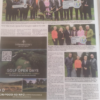Cohaw Megalithic tomb is a neolithic dual Court Cairn dating from 4,000 BC. It is regarded as the finest example of a double court tomb in Ireland. It was excavated in 1949 where remains of Children, both cremated and inhumated, were found here, as well as some clay baked pottery.
Excavation and finds
Cohaw court tomb is located on the side of a ridge, in a marshy hollow 4 kilometres south-east of Cootehill, and is visible from the R192 road between Shercock and Cootehill. The tomb is known locally as the “Giant’s Grave” and was originally built as two single tombs. Each tomb consists of a court at each end, connected by a long, five chambered burial gallery. The south court is two thirds of a circle in shape, while the north court is u-shaped. The northern court contains two post holes that would have held large pillar-stones. The tomb stands in a 24.5m long and 13.5 m width rectangular cairn and is part of the accurately aligned N-S gallery. Although referred to as a ‘dual court tomb’, it is two separate single court tombs, each with two chambers, joined together by & sharing another chamber.
There are two possible derivations of the name Cohaw: (a) from Comhad, a grave, or (b) Coagh, a cup-like hollow. The monument has been extensively used as a quarry and county council workmen utilised the cairn stones for road making shortly after the war. Local residents have related how some of the missing orthostats are known to have been incorporated into the structure of the new church at Cootehill.
The monument was excavated by Kilbride-Jones in 1949 (published 1951) and cremated and uncremated bones and some teeth were found during the excavation which represented at least three individuals. Part of a Neolithic pottery bowl was also recovered. The report on the skeletal remains that were found in two chambers was carried out by Prof. E. Keenan. A few young teeth were also recovered and Keenan concludes that ‘the number and condition do not permit of any accuracy in assessing age but certainly the individual was under twenty years of age and probably much younger’. The right side of a skull was found in a separate chamber together with some individual teeth. The fragment of the skull is not complete enough to permit reconstruction of a replica or of measurements to be made. The teeth, nine in total, show incomplete roots and absence of eruption. This Keenan concludes shows ‘the specimen is that of young individual (probably male) aged between ten and fifteen years’. Also in the same chamber was a small quantity of cremated bones which included limb & skull bones and ‘appear to belong to a young individual, probably of the first decade of life’. The sole find of pottery consisted of almost 1 1/2 pounds of sherds. The pottery was thin, hard and with fine grit content. It has been very thoroughly baked to a colour varying from very dark chocolate to black. It has a pronounced carination and a rolled over rim typical of Neolithic A*, with no decoration (* Neolithic A refers to the earliest pottery type in Ireland).
http://www.megalithicireland.com/Cohaw%20Court%20Tomb.htm
http://www.megalithicmonumentsofireland.com/COUNTIES/CAVAN/Cohaw_CourtTomb.html





